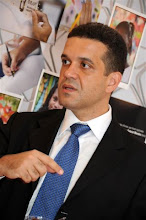- Back to Home »
- Siemens Global Network of Innovation

Networks are the talk of the town. Scientists, economists, politicians and philosophers all speak about networks. When people speak about networks, they are always actually speaking about the special relations that make something what it is.
Thus the effectiveness of a medication is based on its molecular components and the special configuration in which these relate to each other. Decisive are not just the "ingredients" but to a large extent the special position of the building blocks in relation to each other.
Siemens is about to win the Finep1 Technological Innovation Prize in Brazil regarding to its Global Network of Innovation.
This can be translated as the company's innovative strength, its innumerous business activities and, of course, its global network, composed of more than 400,000 employees in 190 countries.
Networks describe both complex structures and the special position of the individual elements as a system of relations. Elements such as nodes and links, representing in such case companies and business relationships, can be build and turned on or turned of to accomplish unparalled actions such as new products, process and services.
Siemens acts, like the catalyst - as we speak about chemical complex structures, of this complex structure. In chemistry, a catalyst (Greek: καταλύτης, catalytēs) is a substance that accelerates a reaction, without itself being consumed or changed. In this case the catalyst, or Siemens, change and change a lot, learning with the business environment and participating in the process of innovation, research and entrepreneurship of people, universities, research institutes and companies around it.
Our social world is an intricate universe of social, economic and political relations. Our world is complex. To be sure, this is not a new phenomenon. But it is a fact that the complexity of the world around us is becoming increasingly difficult for the individual to grasp. Companies, like Siemens, are drowning in the short-sighted probabilities of their own decision-making structure. It is becoming increasingly difficult to find a basis for sensible reforms, and new groups of clients are increasingly difficult to reach in a fragmented market. Today's formula is to became one of the nodes or became the catalyst. Siemens is strongly represented in Brazil. The Company's first activities in the country date back to 1867, with the installation of the first telegraph line between the states of Rio de Janeiro and Rio Grande do Sul. In 1895, in Rio de Janeiro, it opened its first office and ten years later the Company was founded in Brazil. Siemens is among the leading companies in Brazil's electric and electronic sector, with business activities in the areas of Information and Communications, Automation and Control, Medical, Power, Transportation and Lighting. In Brazil, the Company possesses 10,305 employees, seven research and development centers and sixteen manufacturing facilities, some of which occupy a prominent position within our worldwide organization. Such is the case with the Curitiba plant, a global export center of the HiPath 1000 and 4000 corporate communication platform, marketed worldwide by Siemens.
Siemens is strongly represented in Brazil. The Company's first activities in the country date back to 1867, with the installation of the first telegraph line between the states of Rio de Janeiro and Rio Grande do Sul. In 1895, in Rio de Janeiro, it opened its first office and ten years later the Company was founded in Brazil. Siemens is among the leading companies in Brazil's electric and electronic sector, with business activities in the areas of Information and Communications, Automation and Control, Medical, Power, Transportation and Lighting. In Brazil, the Company possesses 10,305 employees, seven research and development centers and sixteen manufacturing facilities, some of which occupy a prominent position within our worldwide organization. Such is the case with the Curitiba plant, a global export center of the HiPath 1000 and 4000 corporate communication platform, marketed worldwide by Siemens.
Don't you think that the Global Network of Innovation deserves this prize?
1 Finep - National Agency for Financing Studies and Researches, is a part of the Ministry of Science and Technology (MCT) created in 1986 specifically for directly promoting and funding R&D&I in Universities and now directly to Private and Public Companies with Federal Government sources.












